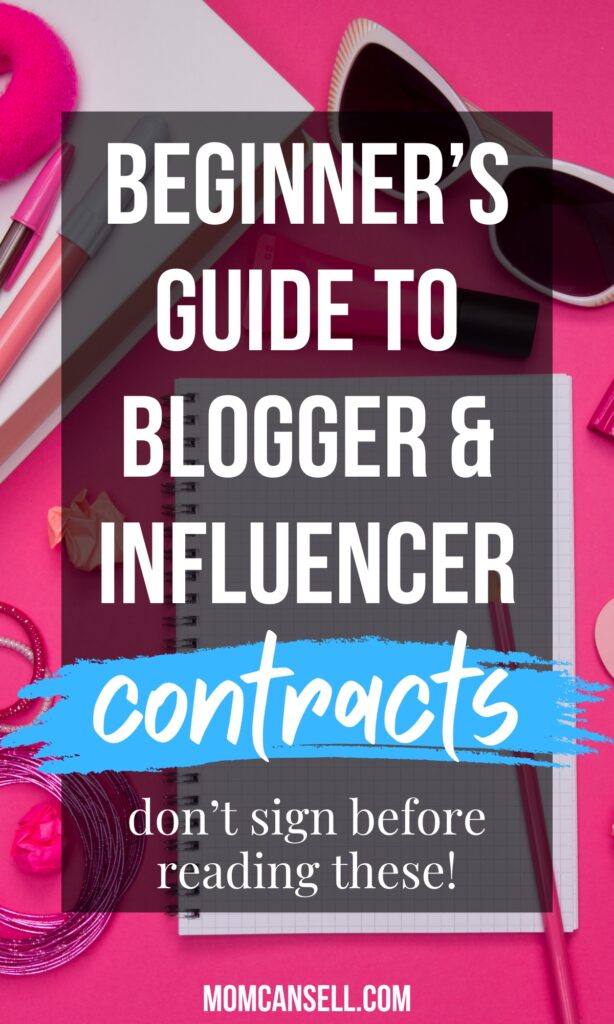This happens FAR too often with bloggers and influencers. They manage to find brands to work with, write a compelling email pitch to brands, and put together a stunning blogger media kit. However, when the time comes to make a brand deal, they don’t secure a blogging contract and don’t get paid. After brokering over $500,000 in brand sponsorships, I can’t stress this enough: You need a blogger collaboration agreement to make sure you get a fair deal! And I’ll show you how to do it.
This post outlines everything you need to know about blogging contracts. Even if you’re new to the game! We’ll go over why contracts matter, what to look for in a good one, where you can find blogger contract templates, and how you can even make changes to contracts.


Why You Need A Blogging Contract
Mama always said get it in writing – that’s true for conventional employment AND freelance work as an influencer.
An influencer agreement is just as strong as an employer agreement for any other job! Both clarify that you will get paid for your work and you have a stronger case if it doesn’t happen.
If any exchange of money happens, you need to cover yourself in case the other party doesn’t uphold their end of the deal.
Blogger collaboration agreements also serve a few other purposes:
- Make it clear what the brand expects you to do (or not do)
- Makes you look more professional
- Answers questions about the brand deal in one place to eliminate muddy back-and-forth email or video call exchanges
- Sets terms for each stage of the process, from turning in work to getting paid
- Cover topics you might not normally discuss in making the initial deal, such as usage rights
It doesn’t matter if you’re a brand new blogger, a micro-influencer, or highly experienced in sponsored brand deals. Everyone needs a contract and the most reputable brands will give you one no matter your experience level. For many brands, it’s just standard procedure.


Blogger Collaboration Agreement Formats
Blog partnership agreements can take several forms, including the ones shown here. What’s the difference between them?
- A Master Services Agreement provides the legal framework for your relationship as a whole with the brand. It can go over some of the more nitpicky items in a contract that don’t have as much to do with the specific campaign you’re working on, and more to do with just covering everyone legally.
- The Statement Of Work goes over the legal terms relating to the specific project you’re working on with the brand. It can just be for one post, or it could be a series of posts as long as they were agreed to all at the same time.
- Many general blogging contracts combine both of these into a general contract. However, there are benefits to splitting them into these two documents if you ever create your own.
Say you got a brand who really wants to work with you long-term over a series of sponsored posts. They can sign your MSA and a SOW the FIRST time you decide to work together.
Then, after that project, they can just sign more SOWs going forward if they want to keep working with you. They don’t have to sign an MSA again unless you change something about it, but if you make a really good one the first time around it’s rare that something will change in it.
And even if a brand is just interested in working with you one time, you can still have them sign both these documents and they will be just as legally binding, while also keeping you open to working with them again in the future.
The other benefit to the MSA is that if you create it right, you can reuse it with different brands over and over, and just focus more on the SOW when you’re in the negotiation stage.
There’s no wrong way to format a blogger sponsorship contract, though, as long as it includes the essentials outlined below.


What To Include In A Blogging Contract
Want to write your own brand collaboration agreement or let the brand do it? Either way is fine! Just read it closely to make sure it covers these 10 items at minimum:
- Identify the parties
- Project term
- Payment terms
- Project scope
- Intellectual property rights and usage
- Exclusivity
- Termination
- Dispute resolution and contract changes
- Confidentiality
- Limitation of liability
1. Identify the parties
You need names and addresses for both parties. If your business is an LLC you would use that information here. If you’re a sole proprietor you would just use your name and address.
For payment purposes, this is also a great time to get a contact for your client’s accounting or accounts payable. You’ll want to have an extra person to reach out to in case you run into payment issues.
2. Project term
Next thing you’ll want in the blogging contract is the beginning date the MSA or contract in general is effective. At least for the sake of the MSA, that date is usually the day you send it to the brand.
The term can also cover how long branded content must stay live on your blog or social channels. You don’t have to leave it there forever — only as long as you legally have to.


3. Payment terms
The brand must promise in the influencer collaboration agreement template that they’ll pay whatever payment you both agree on. (Not sure what to charge? Use my blog post rate calculator.) The amount can be specified here or in a separate SOW.
The contract also needs technical details about invoicing and HOW the brand will pay, including:
- A payment timeline (typically net30, which is 30 days after the client receives your invoice)
- What the brand will do in the event their payment method gets declined for insufficient funds
- Overdue fees you will charge
- What the brand will do if they want to dispute a charge
- Where the brand will send checks for payment (such as a physical address, PayPal account, etc.)
- Who to make the check out to
You also need to address payment terms in the blogging contract. Influencers go in a few directions with this:
- Invoice in full after creating all the work
- Take half upfront to reserve the date on the calendar (and/or fund any upfront costs) and get that payment before the deliverables go live. Then, invoice the other half before live posting
- Take a small deposit, like 10 percent, just to ensure that the brand is financially invested in the deal
- Take payment plans (which I don’t personally recommend because it can cause non-payment down the line, but that’s an option if you’re willing to take a bit of a risk)


4. Project scope
This is mostly what the SOW would cover, but again, you can find it all in one general influencer contract.
The scope is the general idea of what you’re giving to the brand. It might be a post, a series of videos, a general package of media… those should get outlined here.
The document should outline all the deliverables – every social post, every blog post, every email you’re sending out for them. Just everything.
Include the dates for when items are due and when they will go live. It’s okay if these are approximate or a date range.
The scope of work can also address how many revisions the client gets, how quickly they need to respond about revisions, and potential re-shoot fees.
Finally, look for any logistical terms about getting the campaign done successfully in your SOW. So, is the brand sending you product? How soon are they sending it to you? That should all be included in the blogger collaboration agreement.
The scope of work may also include talking points, guidelines, or a creative brief for the campaign, but you might also address these outside the document.
5. Intellectual property rights and usage
Who gets rights over your content after submitting it? Your sponsorship agreement letter needs to answer that question.
By default, you should state that you own everything you’re creating, and that the brand’s usage is limited to the agreed-upon campaign. If the brand wants to use your content after the campaign is over for other marketing and advertising, that needs extra fees.
I’ve seen brands swipe influencer content – even content from influencers they never contracted with – and use it for their own purposes. If they don’t have a written agreement with you to do that, you have a good case against them and can ask them to remove it.
Usually rights to post on social (with credit back to you) are often a given in a blogger collaboration agreement, but going anywhere beyond that (company newsletters, print ads, social ads and so on) without attribution should absolutely cost extra.


6. Exclusivity
Exclusivity means that the brand wants you to only work with them and none of their direct competitors for a certain period of time. And you can charge extra for that!
If signing for exclusivity, specify with a timeline of how long exclusivity will last and how much the brand is paying for it. Exclusivity comes with the cost of losing potential income to other paying competitors.
Remember, this is only for brands that directly compete with each other. You can usually mention other products in your post if they’re completely irrelevant to the paying client.


7. Termination
Your sponsorship agreement form needs a termination clause, aka, how either you or the brand will get out of the agreement if you need to for whatever reason.
Some contracts will still be partially binding after termination, such as clauses about indemnification, getting paid, or limitation of liability (more on that below). It’s especially important to specify that you’ll still get paid for the work you did if the brand terminates!
One brand I worked with terminated two-thirds of the way through a 3-post campaign – even after completing the third post. Because of the termination clause in our blogger collaboration agreement, we still got paid (after some extensive arm twisting and threatening legal action).


8. Dispute resolution and contract changes
There are small details that make a huge difference in a blog post agreement, such as a clause stating you’ll both follow the laws of your state and mentioning where legal conflicts will be resolved (which is usually also your state, but may be different if the brand drafts the contract).
Plus, your blogging contract should go over how to approach changes in the contract. For example, some outline that both parties have to sign if the document gets changed in any way.
9. Confidentiality
A sponsorship agreement contract should also cover how you’ll treat one another’s confidential information.
For example, if you’re working on a sponsored blog post, the brand would agree to not share that information before it publishes.
And on the brand side, if they had a big sale coming up, you wouldn’t share it ahead of time. These are just examples, but there should be language in there enforcing that you’ll both keep confidential information confidential.
10. Limitation of liability
This sponsored blogger contract clause means that neither side is liable for damages to you or the brand that happen as a result of the campaign.
Those kinds of damages can include indirect things, like loss of sales for other products you sell.
It also usually means the liability isn’t worth more than the money exchanged with the brand over a set time period, like 12 months.
Note: A brand influencer contract can also include other terms for extra coverage such as:
- Indemnification: Means the brand will legally cover for you if you promote their stuff and someone comes after you because of consequences they experienced after buying the product or service.
- Representations and warranties: A section like this would say that both you and the brand have the authority to sign the contract, and that there’s nothing keeping it from being enforceable. Warranties can be things like you warrant that you’ll meet the standards the brand asks for in the campaign, you warrant that you’ll follow the law, and you won’t do anything to talk trash about someone or take someone’s intellectual property to get the campaign done successfully.
- Force majeure: Says that neither side will be at fault if you’re late on a deadline because of some catastrophic event outside of your control.
Finally, your agreement needs space for signatures and dates by both parties – so we know who agreed to the terms and when.


Are Blogger Contract Templates Worth It?
I’m not a lawyer. I’m not qualified to give legal advice. However, in my experience, the safest way to write a blogger collaboration agreement is with a hired lawyer who can make a one-time Master Services Agreement and Statement of Work template with a few blanks you can fill in.
Of course, that’s the most expensive option. On the other hand, it’s a one-time cost and you’ll have documentation for every brand deal that covers your best legal interests… for years to come.
That said, you’re a busy blogger on a budget – I get it! So your next best option is finding a lawyer that sells blogger contract templates at a lower upfront cost. This is the template I currently recommend for bloggers and influencers.
With a premade template, you still get a lawyer’s insight without the high cost. However, you’re not getting any customization, and I have yet to find a template that exhaustively covers all the terms laid out here.


Still, it’s a good middle-of-the-road option for beginners to cover your basic legal needs until you can afford a dedicated lawyer in the future to help you draft something customized. If you want to shop around, you can always ask template sellers if they offer some of the specific items covered here.
Of course, you can also let brands draft up your contracts (and often, they will insist on doing so). However, it comes with the most drawbacks.
For starters, brands pay lawyers to draft contracts and generally write them in the brand’s best interest. You may find a lot of red flags as you read it, which can mean longer negotiations. That back-and-forth can sour the conversation if it drags on for too long.


How To Revise A Blogging Contract
If you agree to some parts of a blogger collaboration agreement and not others, you can request revisions!
For example, say their contract sneaks in exclusivity when you never agreed on it. You can simply ask them to eliminate the exclusivity clause! Or, say their payment terms are net90 (which is crazy but not unheard of). You can just ask them to change it to net30, which is closer to the expected standard.
But what if you have more detailed edits across the whole document? Here’s what to do:
- If the influencer marketing contract is formatted as a PDF, ask the client to send it as a Word document for redlines (aka edits)
- Use the track changes feature in Word (or “suggesting” mode in a program like Google Docs) to add or eliminate text
- Make sure your changes are displayed (text is a different color, there are strikethrough lines where you delete things, etc.)
- If needed, use the comment features in these tools to ask questions or make clarifications
- Save as a document file, NOT a PDF. Test that you can see the changes in the document, and return it to the brand
In many cases, the client will take your changes and send back a new PDF. Read the revisions AGAIN and cross-check against the original document to make sure they actually implemented your changes.
In some cases, they won’t say yes to everything. If so, you’ll have to weigh if it’s worth it for you to move forward.
Sometimes, they just miss one small thing, so you could send back a quick email and see if they just forgot to change it. But if it’s a lot of changes, that will take deeper consideration on your part on whether it’s worthwhile to continue with them.


Bottom Line: Always Get A Blogging Contract
Don’t wait until a brand burns you. Protect yourself with a blogging contract and make sure it covers all the basics, from how your intellectual property will get used to how the brand will pay you.
As long as your blogger collaboration agreement covers the essentials (and you read through the document entirely), you can sign with confidence knowing you’re covering your best legal interests as a creator.



